#fir trusses
Explore tagged Tumblr posts
Photo

Contemporary Dining Room in Denver Mid-sized trendy dark wood floor great room photo with beige walls, a two-sided fireplace and a stone fireplace
0 notes
Photo
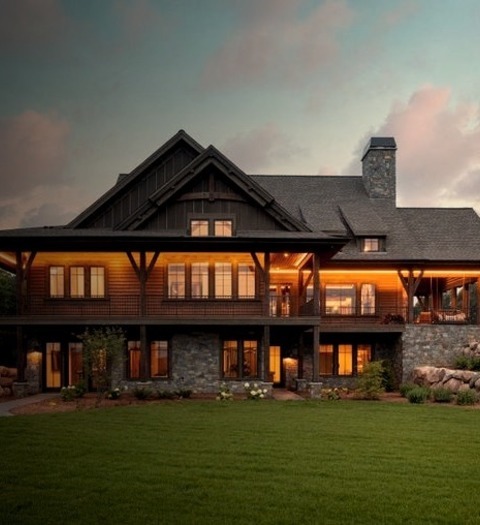
Minneapolis Exterior Inspiration for a huge rustic brown two-story wood exterior home remodel with a shingle roof and a black roof
#jackson hole#cross lake#wayzata#metal fireplace shroud#timber truss#cabin retreat#douglas fir beams
0 notes
Photo

Traditional Family Room Chicago Example of a huge classic open concept medium tone wood floor family room design with white walls, no tv, a standard fireplace and a stone fireplace
0 notes
Photo

Home Bar - Contemporary Living Room Idea for a large, contemporary, open-concept living room with a bar, white walls, a standard fireplace, a metal fireplace, and a media wall
0 notes
Text
Exploring the Hunku - By Jake Norton (part 1)
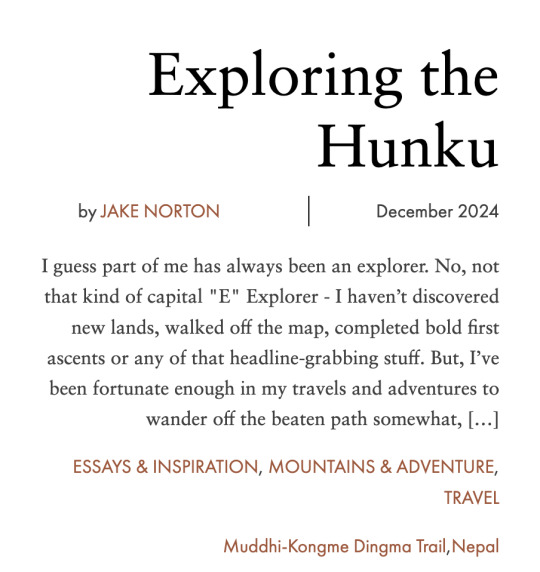

I guess part of me has always been an explorer.
No, not that kind of capital "E" Explorer - I haven’t discovered new lands, walked off the map, completed bold first ascents or any of that headline-grabbing stuff. But, I’ve been fortunate enough in my travels and adventures to wander off the beaten path somewhat, to explore terrain that, if not new to the world, is new to me, unfamiliar in all ways, be it on Everest’s North Face, the slopes of Gurla Mandhata, my own back yard, or elsewhere.
Our venture up the Hunku Khola from Chheskam to Kongme Dingma was just such an exploration. Sam and I and our team were not in uncharted waters; if we’re being honest, there is little in Nepal outside the extreme alpine realm that has not seen the feet of a herder or the staff of wandering ascetic over the ages. No, the Hunku is well known to the Kulung Rai and other locals, but not so to the outside world. I know of only a handful of people who have been up there before, one being Tim Macartney-snape, and if you know him and his history he’s not one for following the known path. So on December 6, we headed off into the somewhat unknown.
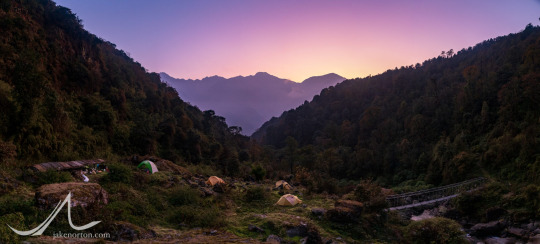
Sunset at camp 1 on the Mahakulung Muddhi-Kongmedingma Trail at the Mangan Khola.
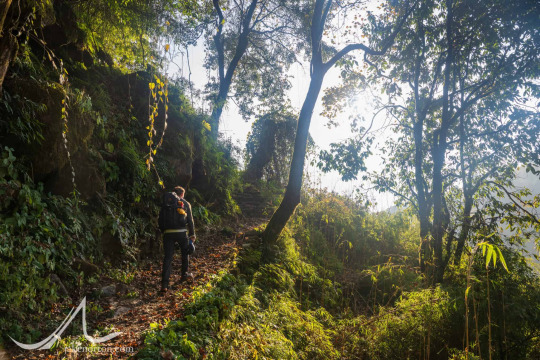
Sam hikes up through lush forests of the Hunku Valley.
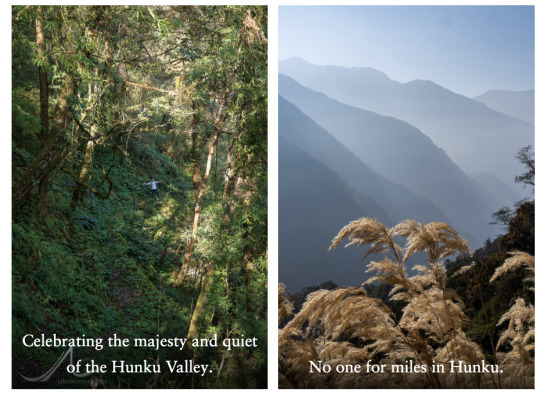
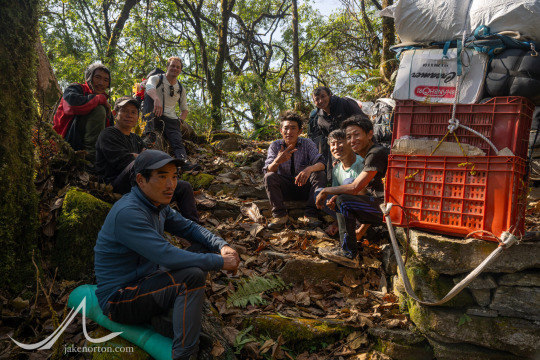
Our amazing team taking a breather.
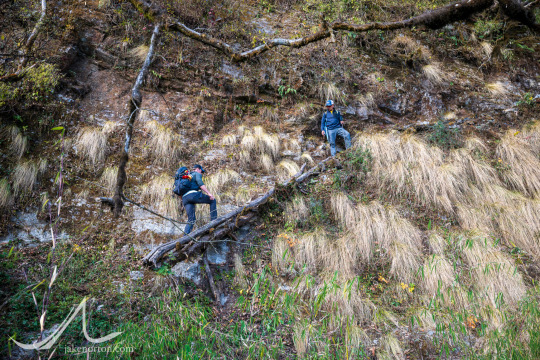
New ways to traverse cliffside trails.
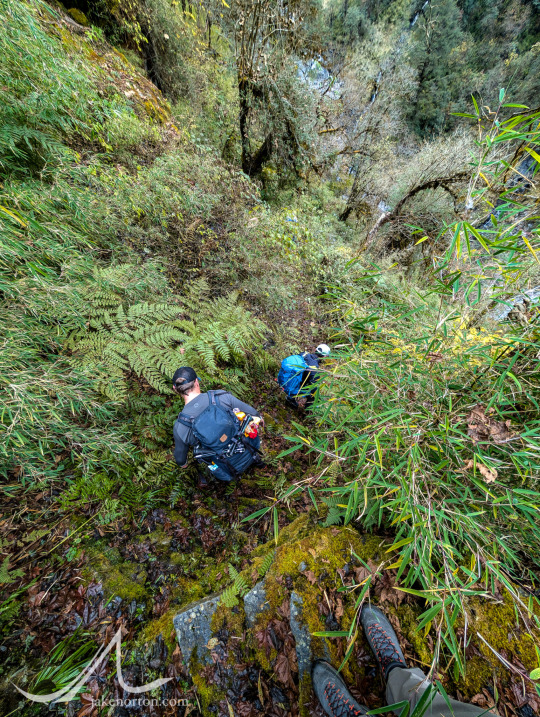
Steep and slick but full of beauty.
The new trail - dubbed by the excited community of Mahakulung as the Mahakulung Muddhi-Kongmedingma Trail - follows the Hunku Khola as it roars through a narrow canyon of its own creation. Unlike many treks in the Nepal Himalaya - and quite different than its nearby neighbor, Khumbu - this trail ambles through dense jungle, towering forests of East Himalayan Fir (Abies spectabilis), Musure Katus (Himalayan beech, Castanopsis tribuloides), Bull oak (Quercus lamellosa), Himalayan birch (Betula utilis), and rhododendron (both falconeri and arboreum). It’s a misty place as well, with afternoon cloud wafting up the valley, enshrouding the landscape in mystical ether turning to ethereal ice during the night.
While the Hunku finds its source up high in the melting ice of the Hunku Glacier on Baruntse and the alpine lakes of Seto Pokhari and Paanch Pokhari, its power is fed downstream by countless tributaries large and small, azure cascades coming down from numerous unnamed 5,000 meter peaks and larger, named ones like Naulekh and Mera. Thankfully, the municipalities of Mahakulung (Gudel, Bung, and Chheskam) built bridges across most, ranging from simple trusses to deluxe covered bridges and simple sticks-on-rocks for yet others still.
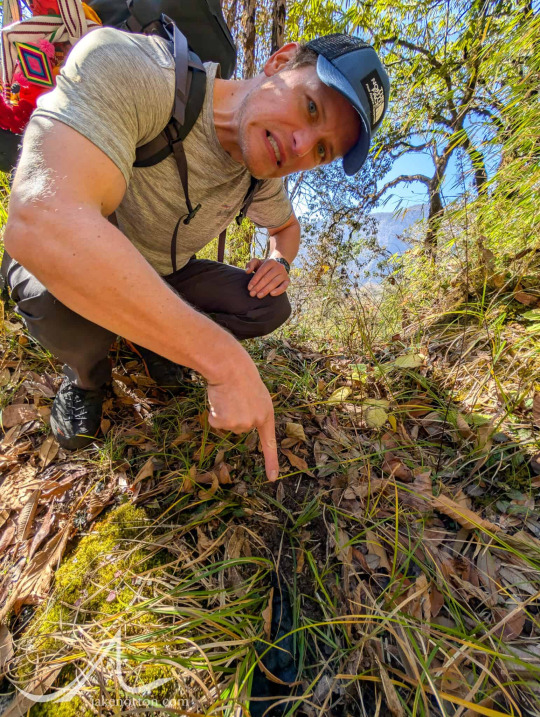
Sam shows his excitement at finding scat of a large leopard on the trail.
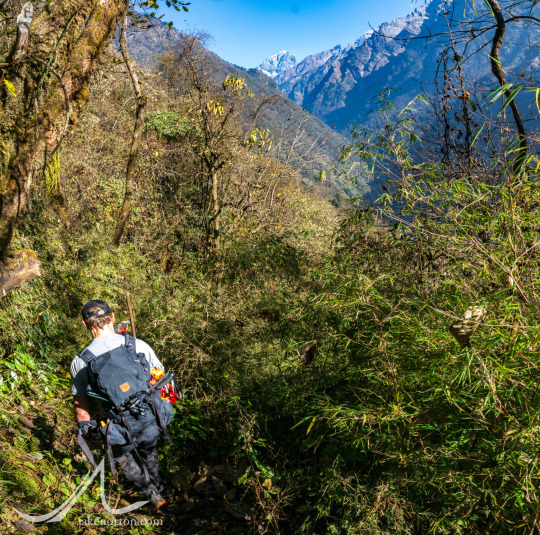
Bamboo tickets and high peaks.
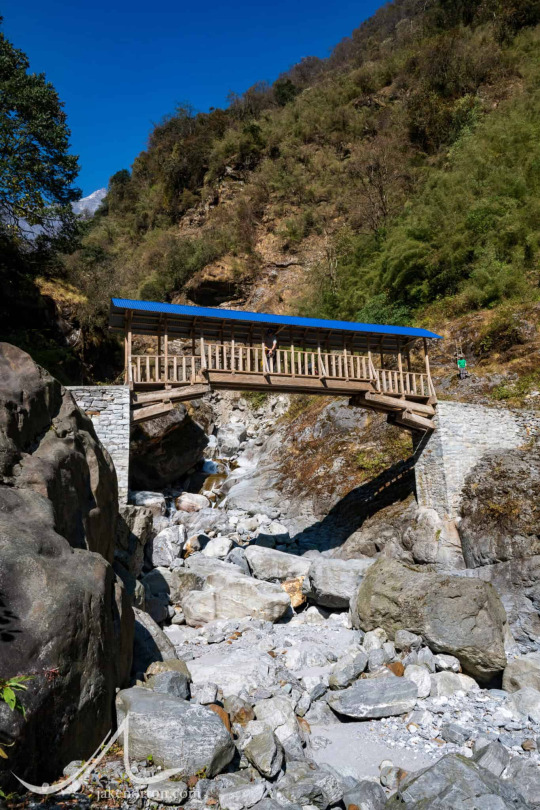
A new bridge on day 3 crossing a tributary to the Hunku Khola. Bridges were built by locals from Mahakulung.
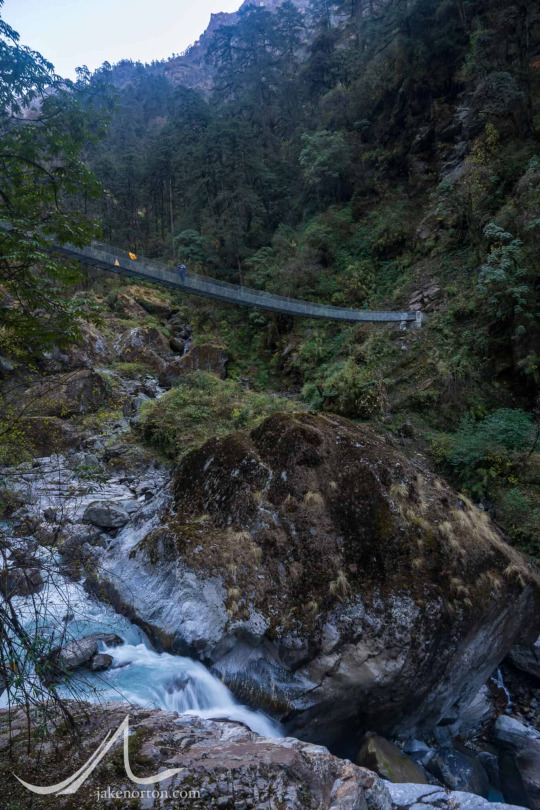
A new suspension bridge crosses the Hunku Khola on day 4.

Chilly mornings.
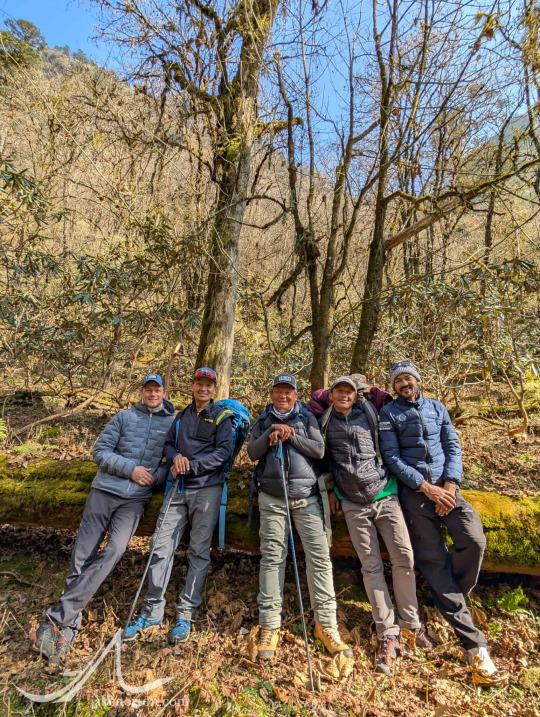
The boys on a break. Left to right: Sam Heughan, Tshering Dorje Sherpa, Gopal Magar, Karka Kulung Rai, and Jhanak Karki.
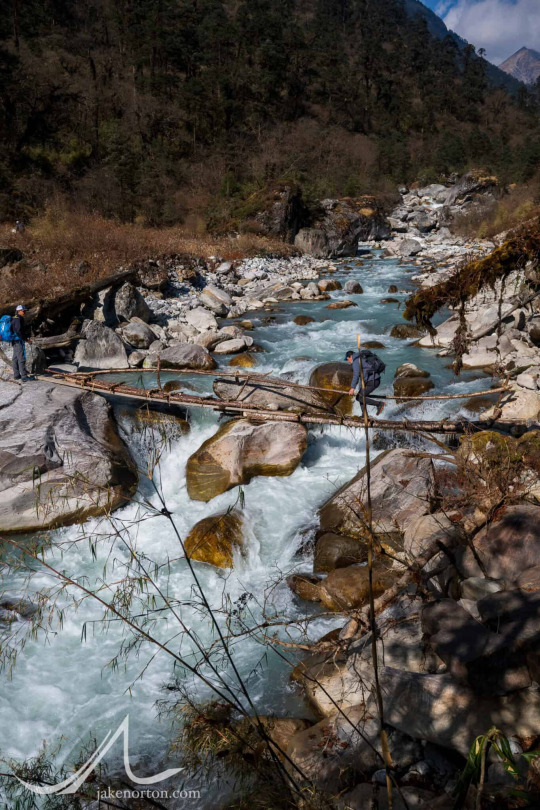
Sam crosses a less-modern - and fully iced - bridge on the upper Hunku Khola.
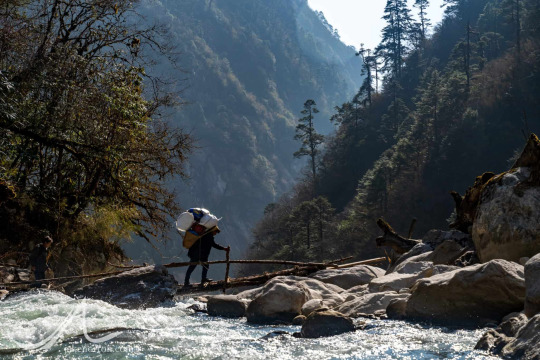
Porters crossing an old wooden bridge on the Hunku Khola.
Our trail - choked at times with bamboo or slick with mud, glazed with ice - meandered along the Hunku’s path. Folded as they are, the Himalaya do not lend themselves to easy trails, however, and the Muddhi-Kongmedingma is no exception: a straight line from Point A to Point B is rarely possible, with Ridge C and Valley D more often standing in the way. While most days the trail had a net gain of about 1500 vertical feet, we’d easily double that with ups and downs along the way.
But, that’s not to say days were hard; they were, taken all together, about perfect. Much of that is thanks to our team, and wonderfully motley crew of folks helping schlep our gear and prepare meals and keep us company along the way. And, this being the first real commercial trip up the valley, we never knew with certainty where the next flat ground would be found and if it would have water nearby. So, some days were cut short, some were stretched longer. Vagaries of the valley forced the abandonment of one acclimatization day at Watelma Chaur, but to little consquence: we were nimble, Sam was strong, our team able.
Six days of fairly magical, mystical trekking took us through climatic zones from forest to alpine, through sun and snow and ice, mornings of frost to afternoons of heat and frigid nights tempered by a blazing fire. We found scat from jungle cats (Asiatic wildcat? Maybe, but quite doubtful.) and leopards (common or snow, we do not know), enjoyed unspoiled nature at its best, and barely a trace of humanity - not a lodge, not a house, not a helicopter or plane. The only person outside our team we encountered until Khumbu was a resourceful Sherpa named Gelu from near Bung who heard of our affinity for both jhway kathe (raksi heated and adorned with sauteed fenugreek) and tongba (fermented millet prepared as a delicious hot drink) and decided we were a good business proposition, hauling several liters of both in his doko up valley. (Note, his instincts proved remarkably correct.)

Jhanak Karki, skull shaman.
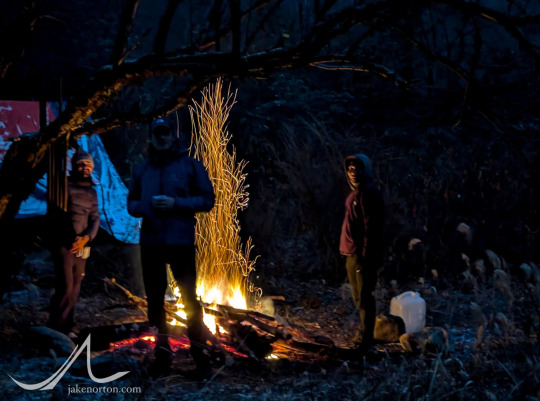
Keeping warm by the fire at camp on day 4.
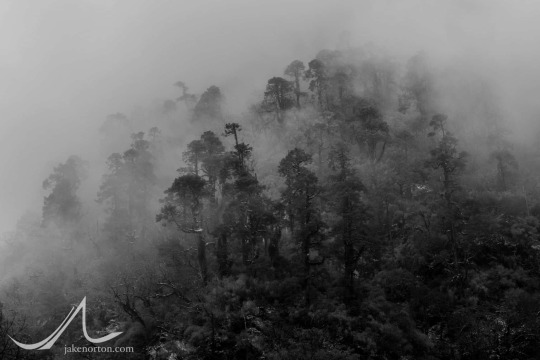
Misty morning majesty.
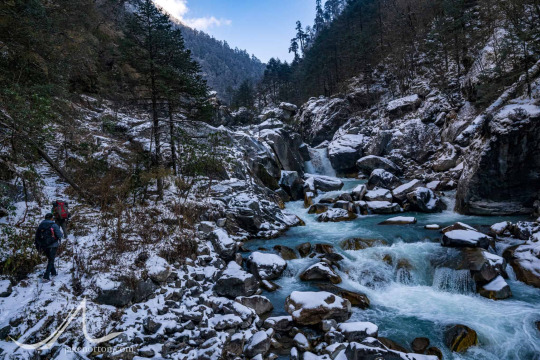
Fresh snow helped make day 5 on the Mahakulung Muddhi-Kongmedingma Trail even more stunning.
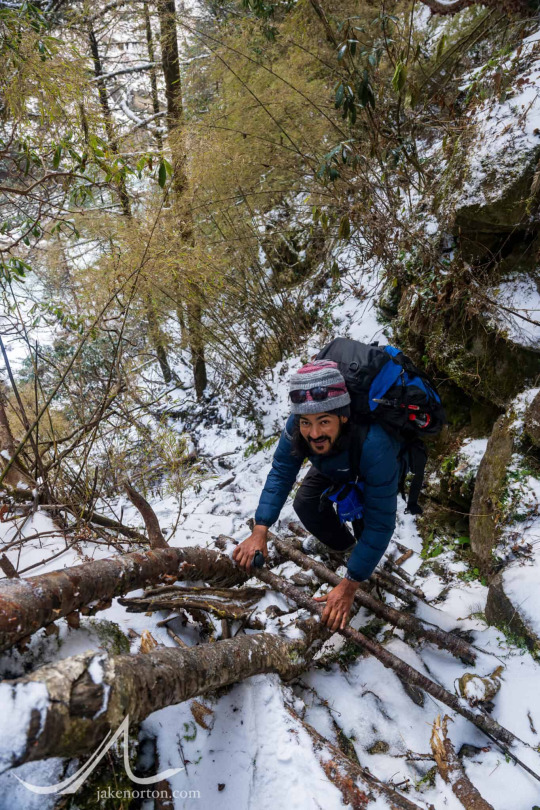
Steep and slippery demands creativity.
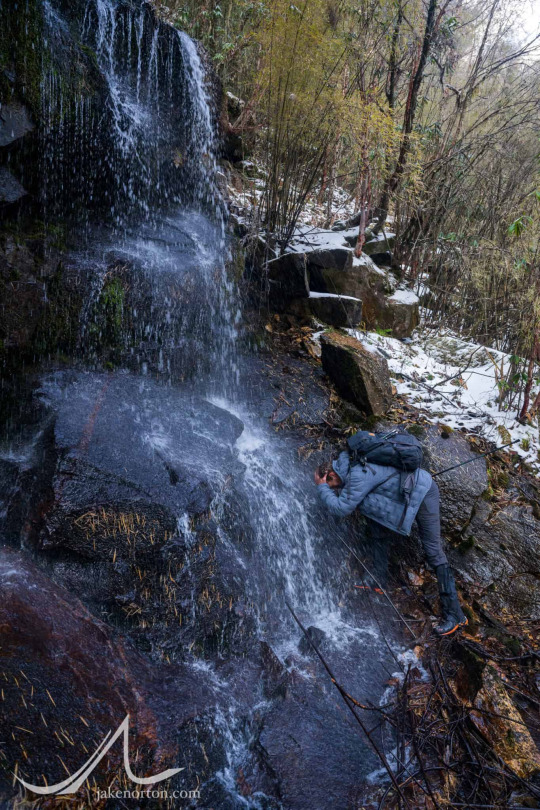
Sam enjoys a cold head shower along the trail.
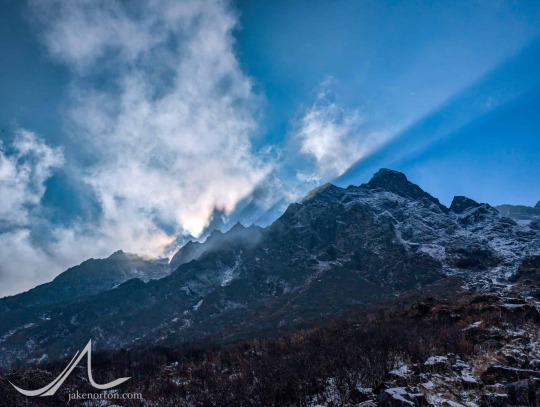
Sun, shadow, and cloud play on the shoulders of Naulekh.
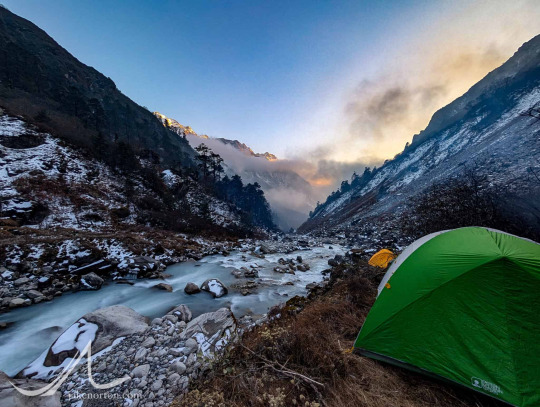
Sunset at our tiny cliff camp on the Hunku Khola.
Eventually, we emerged from the forest some 2500 feet below Kongme Dingma and entered the subalpine zone. Here, along with incresingly majestic views of Naulekh and Peak 41 and Chamlang and more, we bushwhacked for an hour through sprawling hillsides of sunpati (dwarf rhododendron, or Rhododendron anthopogon), which is used in most incense from South Asia. So strong and fresh, every step released a burst of aroma making the whole valley akin to walking around Bodhanath during times of prayer. Amazing.
And then, the pain began.
Not bad pain, but certainly some, the hurt of altitude and the cold that comes along with it, the toll extracted physiologically, penance for the privilege of the high country. And, like a first marathon or a first drunk, it hits the uninitiated hardest. We made it to Kongme Dingma, a small, vacant settlement at 15,750 feet, windswept and austere beneath the towering giants of Peak 41, Naulekh, and Chamlang. For Sam and Jhanak, each step of the last 3000+ feet was an altitude record, and inevitably the night brought with it headache and lassitude, the hallmarks up here. But, they fired back with their own hallmarks - grit and positivity.
We spent the night sheltering from demonic, 60 mph wind gusts under Gelu’s tarp-roofed hut. Dung-seasoned dust whipped about as we ate dal bhat, played cards with the team, laughed and talked and smiled and knew that this too would pass, tomorrow would dawn another day.
Altitude is a fickle thing, each person’s specific physiology responding differently to it. Until you’ve been up high, it’s generally a mystery as to how you’ll do, how your body will adapt - or not - to the dearth of oxygen. Some do well, some less so, but most will get it sorted out if given time and tools. Time is the keystone, as the body is working overtime to produce red blood cells and increase hypoxic efficiency; thus, a day off, an active rest day, at Kongme Dingma was essential to let the body do its thing.

Sam taking it all in as we leave the forest and enter the alpine.
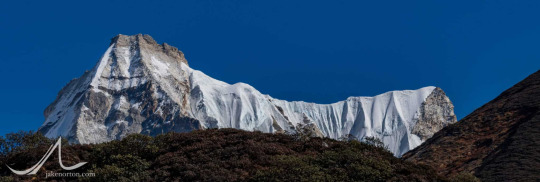
Chamlang - the sentinel of the Hunku - was hidden for days but finally shows itself in the upper valley.
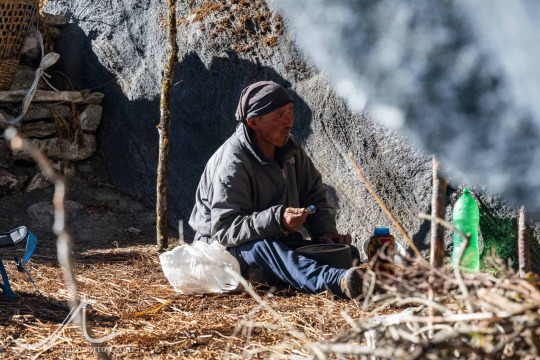
Gelu, our friend and beverage purveyor, stops for a tea and dal bhat break on the trail.
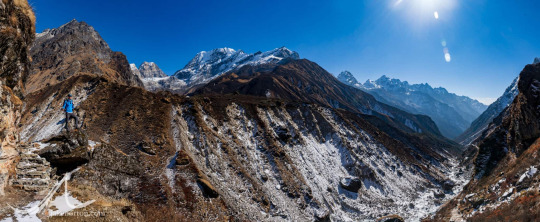

Sam Heughan taking it all in high on the Mahakulung Muddhi-Kongmedingma Trail.
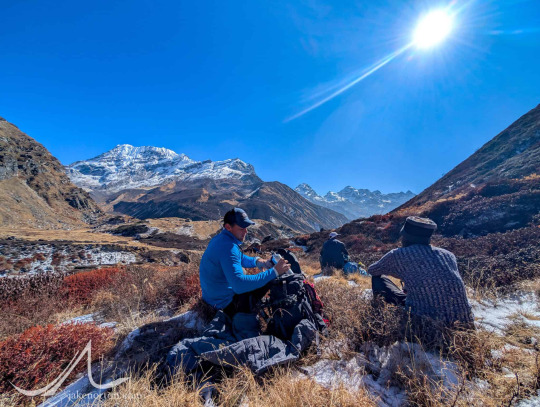
Enjoying the views high on the Muddhi-Kongmedingma Trail.
(more in part 2 of this article)
39 notes
·
View notes
Text
Ichi the Witch ch.10 thoughts
[(N)Ice Boat]
(Topics: thematic analysis - Death for Death/talent, character analysis - Hisame, speculation - Kumugi/Magik/Minakata)
Dammit, I was wrong again, Ichi really did just make sashimi instead of turning Hisame into an outfit...I think @wickedsick predicted that, so good job, Wick
It was certainly well telegraphed, he was literally fileting her, and Desscaras/Kumugi were wearing the iconic sushi chef headband, I just was hoping for something a little more on-theme I guess
I'm not at all disappointed in this outcome, mind you, I'm just bitter about how I keep whiffing on what seem like easy pitches. I'll probably feel a lot better about it on reread, but right now I'm just a bit embarrassed
Enough lamenting though, let's focus on the chapter itself!
Good Enough to Eat
The sashimi boat really is the perfect solution to this trial, honestly. First and foremost, it's a solid reflection of Ichi's philosophy of Death for Death. As Ichi says in the flashback, the sashimi boat is an artistic and ritualistic expression of both respect and gratitude for the prey, the core ideology behind only killing when it is necessary for survival and not wanton destruction in the name of entertainment. The prey's life is not more valuable than the predator's, so Ichi wants to honor the life that he has taken for his own by treating it with dignity
Moreso than just the spirit behind Death for Death, it is also literally taking that philosophy to its logical conclusion by reflecting Hisame's own actions upon her. Hisame enjoyed putting her victims on display, making their frozen corpses into macabre architecture, so it's only fair that the same would be done to her. A punishment that fits the crime
However, it also is what allows Ichi to actually pass the trial because while it is a gruesome fate, it is not actually a punishment for Hisame. Like I said, it's a reflection of her own artistic sensibilities turned back on her; she is now the one being put on display as a grotesque art piece - of course she'd find that more beautiful than being trussed up in flowers or frills! She was telegraphing it the whole time!
It's also a fun play on Desscarass' attempt to cheat last week by saying true beauty is on the inside - by rending and exposing her flesh, Hisame can see her literal inner beauty in a way that is both novel and a perfect encapsulation of her sense of aesthetic
I do think that turning her into an outfit would have ultimately had the same effect, but focusing on Ichi's established specialties works much better as a bookend for this arc's themes
Playing to Your Strengths
While I initially wanted Kumugi to learn the lesson of individual capability directly, having her see it firsthand through Ichi's talents is a great way to set her arc on a slow burn rather than simply cooking it all the way through in one shot
Before, she was simply told of the idea, and now she's merely witnessing it in action, but she has yet to personally experience or internalize it, steps that will come later as she's forced to contend with her own shortcomings and insecurities
My guess is that she's meant to be more of the Usopp of the team, who even to this day is struggling to recognize just how far he's come in his personal journey. Like how Usopp had to learn to be brave in increasingly personally challenging scenarios, Kumugi is likely going to be put in scenarios that make her feel less and less suited to them, but through emulating Ichi, will slowly come to learn that her unique capabilities make her just as skilled as Ichi in her own way
But again, I'm getting ahead of myself. For now, what matters is that Desscaras' line about Ichi doing things that only he can do seems to have resonated with Kumugi, even if she doesn't fully understand why just yet
Speaking of things we don't fully understand yet, this chapter has left me with a couple of questions that I'm very excited to see addressed in the future
Gotta Catch 'Em All
First, as this is the first time we're seeing a non-combative trial, is it common for Magiks to be so peaceful when they become magic stones? Obviously Uroro was distraught, but should we expect most of them to be satisfied or even happy to be bested?
And for that matter, what does it actually mean to be turned into a magic stone? We know they can be returned to normal upon the death of their spell holder, but is it more of a seal or a cycle of death and rebirth?
Cus if it's the latter, then Magik psychology must be fascinating, as they're likely able to accept their deaths because they have such clarity of purpose in their lives. If it's the former, though, that raises a bunch more questions about their cognition
Are they conscious while in stone form? Is there any circumstance where they can be retrieved?
Uroro is obviously an exception where he can manifest of his own will, but when Ichi cast Inazuri and Inazuri appeared, was that simply an apparition to represent him, or was it literally Inazuri coming to summon the lightning? He didn't say or do anything, so it seems like it was just imagery, but is it possible that with more advanced mastery of a spell that a Witch can fully materialize a Magik as a familiar?
I'm starting to suspect that this might be the case, as Hisame's last words were "I wouldn't mind letting you take me on a date." Perhaps she meant it metaphorically to represent giving herself to Ichi as a stone, but with how bombastic and unique her personality was, I think it would be a huge shame if she's just gone from the cast forever
On the other hand, though, how many Magiks is Ichi going to acquire? He already has three, and one is already a major cast member; will the other two and all subsequent Magiks become a rotating ensemble cast, throwing in their two cents whenever the author deems it funny or interesting but forgetting about them the rest of the time because there's just too much to keep track of?
Or will they simply be inert, effectively dead to the narrative and only contributing as MacGuffins to solve increasingly specific and harrowing challenges with no semblance of personality or individuality ever again?
Both options sound bad when you put them like that, though they both serve a specific purpose to the narrative that would help it flow. I'm pretty sure that's why Shaman King abandoned the Pokemon-esque ghost of the week premise pretty early, since it wouldn't do to have Yoh juggling a bunch of side characters when one would perfectly suffice. Come to think of it, I think Kagamigami did the same thing...
Only time will tell, but I do hope there is a way for Ichi to connect with his Magiks on a more personal level, especially if it turns out that it's something Witches either weren't aware of or deliberately don't do to avoid forming personal attachments
Even if we don't get more insight into Ichi's relationships with Inazuri or Hisame, though, there is one relationship of his that I'm confident we're going to be seeing a lot more of
Teach a Man to Fish
I have no idea what role he's is going to play going forward or how long it's going to take to get there, but there is simply no way that Minakata isn't meant to be important
Minion to the Big Bad? The Big Bad himself? The Big Good?? I don't know! But mentors that protagonists fondly remember and were heavily inspired by as children always do one of two things: turn evil or die horribly. Sometimes both! Lookin' at you, Kite HxH
I don't want to speculate too much since we've basically learned nothing concrete about him, but being that he's a wanderer with a mysteriously hidden face, I'll bet right now that Ichi's going to meet an oddly large man later, walk away none the wiser, and then the man is going to pull out the deer skull mask and say something cryptic about how much Ichi has grown
Buuut just to make a particularly wild shot in the dark now with no basis whatsoever: I won't be surprised if it turns out that Minakata has something to do with Ichi becoming a Witch. Maybe Minakata did something to him, maybe Minakata is also a Manwitch. Either way, there's definitely going to be an explanation for Ichi winning that lottery and Minakata is currently the best (and only) lead we've got on that
And with that, we've completed the first full story arc. It's definitely proving to be as fun as I expected it to be, I'm just surprised it's taken this long to establish a long-term goal. I won't be surprised if we get another mission to establish a bit more of a daily life-style pattern, but I worry in Jump's current climate that waiting too long to raise the stakes will prove detrimental to Ichi's longevity. It was around this point when Shigaraki showed up in Hero Academy, Geto showed up in JJK, and God was established as the antagonist in Undead Unluck, so I'd say we'll at least get a glimpse of the antagonist in the next few chapters hopefully
Until next time, let's enjoy life!
20 notes
·
View notes
Text

Part 2 of our adventure in the Hunku Valley on the new Mahakulung Muddhi-Kongmedingma Trail from Chheskam to Kongme Dingma. Great memories from an amazing adventure with Sam Heughan, Jhanak Karki, Samdibu Rai, Tshering Dorjee Sherpa, and a great crew of friends, old and new.
Exploring the Hunku
by JAKE NORTON
December 2024
I guess part of me has always been an explorer. No, not that kind of capital "E" Explorer - I haven’t discovered new lands, walked off the map, completed bold first ascents or any of that headline-grabbing stuff. But, I’ve been fortunate enough in my travels and adventures to wander off the beaten path somewhat, […]
ESSAYS & INSPIRATION, MOUNTAINS & ADVENTURE, TRAVEL
Muddhi-Kongme Dingma Trail,Nepal
I guess part of me has always been an explorer.
No, not that kind of capital "E" Explorer - I haven’t discovered new lands, walked off the map, completed bold first ascents or any of that headline-grabbing stuff. But, I’ve been fortunate enough in my travels and adventures to wander off the beaten path somewhat, to explore terrain that, if not new to the world, is new to me, unfamiliar in all ways, be it on Everest’s North Face, the slopes of Gurla Mandhata, my own back yard, or elsewhere.
Our venture up the Hunku Khola from Chheskam to Kongme Dingma was just such an exploration. Sam and I and our team were not in uncharted waters; if we’re being honest, there is little in Nepal outside the extreme alpine realm that has not seen the feet of a herder or the staff of wandering ascetic over the ages. No, the Hunku is well known to the Kulung Rai and other locals, but not so to the outside world. I know of only a handful of people who have been up there before, one being Tim Macartney-snape, and if you know him and his history he’s not one for following the known path. So on December 6, we headed off into the somewhat unknown.


The new trail - dubbed by the excited community of Mahakulung as the Mahakulung Muddhi-Kongmedingma Trail - follows the Hunku Khola as it roars through a narrow canyon of its own creation. Unlike many treks in the Nepal Himalaya - and quite different than its nearby neighbor, Khumbu - this trail ambles through dense jungle, towering forests of East Himalayan Fir (Abies spectabilis), Musure Katus (Himalayan beech, Castanopsis tribuloides), Bull oak (Quercus lamellosa), Himalayan birch (Betula utilis), and rhododendron (both falconeri and arboreum). It’s a misty place as well, with afternoon cloud wafting up the valley, enshrouding the landscape in mystical ether turning to ethereal ice during the night.
While the Hunku finds its source up high in the melting ice of the Hunku Glacier on Baruntse and the alpine lakes of Seto Pokhari and Paanch Pokhari, its power is fed downstream by countless tributaries large and small, azure cascades coming down from numerous unnamed 5,000 meter peaks and larger, named ones like Naulekh and Mera. Thankfully, the municipalities of Mahakulung (Gudel, Bung, and Chheskam) built bridges across most, ranging from simple trusses to deluxe covered bridges and simple sticks-on-rocks for yet others still.




Our trail - choked at times with bamboo or slick with mud, glazed with ice - meandered along the Hunku’s path. Folded as they are, the Himalaya do not lend themselves to easy trails, however, and the Muddhi-Kongmedingma is no exception: a straight line from Point A to Point B is rarely possible, with Ridge C and Valley D more often standing in the way. While most days the trail had a net gain of about 1500 vertical feet, we’d easily double that with ups and downs along the way.
But, that’s not to say days were hard; they were, taken all together, about perfect. Much of that is thanks to our team, and wonderfully motley crew of folks helping schlep our gear and prepare meals and keep us company along the way. And, this being the first real commercial trip up the valley, we never knew with certainty where the next flat ground would be found and if it would have water nearby. So, some days were cut short, some were stretched longer. Vagaries of the valley forced the abandonment of one acclimatization day at Watelma Chaur, but to little consquence: we were nimble, Sam was strong, our team able
Six days of fairly magical, mystical trekking took us through climatic zones from forest to alpine, through sun and snow and ice, mornings of frost to afternoons of heat and frigid nights tempered by a blazing fire. We found scat from jungle cats (Asiatic wildcat? Maybe, but quite doubtful.) and leopards (common or snow, we do not know), enjoyed unspoiled nature at its best, and barely a trace of humanity - not a lodge, not a house, not a helicopter or plane. The only person outside our team we encountered until Khumbu was a resourceful Sherpa named Gelu from near Bung who heard of our affinity for both jhway kathe (raksi heated and adorned with sauteed fenugreek) and tongba (fermented millet prepared as a delicious hot drink) and decided we were a good business proposition, hauling several liters of both in his doko up valley. (Note, his instincts proved remarkably correct.)

Eventually, we emerged from the forest some 2500 feet below Kongme Dingma and entered the subalpine zone. Here, along with incresingly majestic views of Naulekh and Peak 41 and Chamlang and more, we bushwhacked for an hour through sprawling hillsides of sunpati (dwarf rhododendron, or Rhododendron anthopogon), which is used in most incense from South Asia. So strong and fresh, every step released a burst of aroma making the whole valley akin to walking around Bodhanath during times of prayer. Amazing.
And then, the pain began.
Not bad pain, but certainly some, the hurt of altitude and the cold that comes along with it, the toll extracted physiologically, penance for the privilege of the high country. And, like a first marathon or a first drunk, it hits the uninitiated hardest. We made it to Kongme Dingma, a small, vacant settlement at 15,750 feet, windswept and austere beneath the towering giants of Peak 41, Naulekh, and Chamlang. For Sam and Jhanak, each step of the last 3000+ feet was an altitude record, and inevitably the night brought with it headache and lassitude, the hallmarks up here. But, they fired back with their own hallmarks - grit and positivity.
We spent the night sheltering from demonic, 60 mph wind gusts under Gelu’s tarp-roofed hut. Dung-seasoned dust whipped about as we ate dal bhat, played cards with the team, laughed and talked and smiled and knew that this too would pass, tomorrow would dawn another day.
Altitude is a fickle thing, each person’s specific physiology responding differently to it. Until you’ve been up high, it’s generally a mystery as to how you’ll do, how your body will adapt - or not - to the dearth of oxygen. Some do well, some less so, but most will get it sorted out if given time and tools. Time is the keystone, as the body is working overtime to produce red blood cells and increase hypoxic efficiency; thus, a day off, an active rest day, at Kongme Dingma was essential to let the body do its thing.

Winds abated, and we spent a stunning day alternating between rest and relaxation, fueling up with copious water and calories, handwashing clothes in icy streams and ourselves as well if we could stand it. Sam, Tshering, and I also spent a couple hours playing on a nearby ice flow, fixing a rope and practicing Sam’s technique with crampons and ice ax, ascending a line and rappelling the same. As expected, he was a natural, making it all seem like old hat, cruising up and down with a smile and confidence seasoned precisely with the right amount of fear and respect for the terrain waiting days ahead on the Amphu Laptsa.
And with that, Part 1 of our trek - the new trail from Chheskam to Kongme Dingma, the Mahakulung Muddhi-Kongmedingma Trail - was finished. The next day we’d enter the alpine, trekking along an established, but seldom used, trail through alpine lakes under serrated behemoths, then up and over the high Amphu Laptsa pass and into the Khumbu. The days before were, as I’d hoped, spectacular, replete with everything a trek in the Himalaya can deliver (but often does not): scenery, solitude, adventure, great company, and memories galore. And, of course, some exploration.

Moonrise over Chamlang from Kongme Dingma.
As mentioned above, we didn’t chart new territory, make a daring first ascent, or add new data to the geographic lexicon. But, we did explore, all of us. We explored areas that were new to us, new to most. We explored new ways to help the villages of Mahalulung - and the thousands of souls who live there - develop and establish sustainable trekking and the income that goes with it. And, perhaps most saliently, we explored ourselves, pushing our own boundaries even just a little, probing the possible, exiting comfort zones and finding joy through hardship, toil, laughter, and camaraderie. Like TS Eliot wrote in Little Gidding back in the last century, an ode less to Magellanic exploration and more to that of the personal:
We shall not cease from exploration
And the end of all our exploring
Will be to arrive where we started
And know the place for the first time.
Through the unknown, remembered gate
When the last of earth left to discover
Is that which was the beginning…
- TS Eliot, Little Gidding excerpt from "Four Quartets"
Stay tuned for Part 3 of this story - the Hunku alpine zone, Amphu Laptsa, and Khumbu - coming soon.
📸 @mountainworld IG
Posted 30th December 2024
@ imahalfemptykindofgirl -I hope so too; he is a talented writer. I want Jake to make it clear. He is a climber, photographer, and filmmaker who is well-acquainted with Nepal. He originated the idea and is sharing his experiences by writing field reports of the trek on his blog. If someone thinking of doing something on their own, without Jake, he will not be able to overcome it.
14 notes
·
View notes
Text
Douglas Fir Vs Redwood: Uncovering the Superior Wood

Douglas fir and redwood are both popular choices for construction projects and outdoor applications. Douglas fir is known for its strength and affordability, making it a common choice for structural lumber. On the other hand, redwood is prized for its natural beauty and resistance to decay, often used in outdoor furniture and decking. Both woods have distinct characteristics that make them suitable for different applications, but understanding their differences can help in making the right choice for your project. We will explore the key differences between Douglas fir and redwood, examining their properties, uses, and considerations in order to help you make an informed decision for your specific needs. Whether you're looking to build a deck, construct a fence, or create furniture, understanding these woods can have a significant impact on the success and longevity of your project.
The Battle Of The Giants
Douglas Fir and Redwood are two of the most prized lumber species, pitting them against each other in the battle of giants. Both are renowned for their strength, durability, and versatility, but they have distinct characteristics and applications. Let's delve into the history, importance, role in the construction industry, and their sustainability and environmental impact, to reveal which giant ultimately reigns supreme. History And Importance Douglas Fir has a rich history, being one of the first species used in North America for construction. It is widely celebrated for its unparalleled strength-to-weight ratio, making it a valuable resource for structural applications. On the other hand, Redwood boasts a heritage as a prestigious material in the United States, renowned for its natural resistance to decay and insects. This has made it a prime choice for outdoor furnishings, decking, and siding. Role In Construction Industry Douglas Fir has been a cornerstone of the construction industry for centuries. Its exceptional strength, dimensional stability, and workability make it an ideal choice for beams, trusses, and framing. Alternatively, Redwood is prized for its natural beauty and resistance, making it perfect for outdoor applications such as decking, fencing, and exterior siding. Sustainability And Environmental Impact Despite their towering presence in the lumber industry, sustainability and environmental impact are critical factors to consider. Douglas Fir is known for its rapid growth and efficient reforestation, but its commercial demand raises concerns for forest management. Redwood, while regenerating naturally, faces challenges due to overharvesting and decreasing old-growth forests.

Comparing Properties And Characteristics
When it comes to choosing between Douglas Fir and Redwood for your woodworking projects, it’s essential to consider their properties and characteristics. Let’s delve into a detailed comparison to help you make an informed decision. Strength And Durability Douglas Fir is known for its exceptional strength, making it suitable for heavy-duty structural applications. On the other hand, Redwood exhibits impressive strength and durability, particularly in resisting warping and splitting. Resistance To Decay And Insects Both Douglas Fir and Redwood boast natural resistance to decay and insect infestation, thanks to their inherent chemical properties. However, Redwood generally outperforms Douglas Fir in this aspect, making it an ideal choice for outdoor projects. Density And Weight Douglas Fir is relatively dense and heavy, providing stability in construction. In contrast, Redwood is lighter in weight, offering ease of handling without compromising strength and stability. Workability And Versatility With its moderate to coarse texture, Douglas Fir excels in various woodworking processes, including shaping, cutting, and finishing. Redwood, renowned for its straight grain and uniform texture, is also easy to work with, making it versatile for a wide range of applications. Uses In Carpentry And Woodworking Douglas Fir is commonly employed in structural framing and outdoor construction due to its robustness and load-bearing capabilities. Conversely, Redwood finds widespread use in outdoor furniture, decking, and decorative elements, showcasing its aesthetic appeal and durability. Finishing And Maintenance Considerations Both Douglas Fir and Redwood respond well to finishes, allowing for diverse staining and sealing options. However, it's important to note that Redwood requires minimal maintenance to preserve its natural beauty and integrity, making it an attractive choice for long-term projects.
Economic And Practical Considerations
When considering the economic and practical aspects of using Douglas fir or redwood in building projects and construction, various factors such as cost, availability, market demand, environmental impact, and forestry management practices come into play. Making informed decisions based on these considerations is crucial for builders, architects, and homeowners aiming to balance the economic and ecological aspects of their projects. Cost And Availability Both Douglas fir and redwood are valued for their strength and durability, however, certain differences affect their cost and availability. Douglas fir is more widely available and tends to be more affordable due to its faster growth rate, making it a practical choice for various construction projects. On the other hand, the limited availability of redwood due to environmental concerns can result in higher costs and constraints on its use in construction. Market Demand And Pricing Trends The market demand for both types of wood influences their pricing trends. Douglas fir, being more widely available and commonly used in construction, often experiences more stable pricing due to consistent demand. Meanwhile, the scarcity and high demand for redwood can lead to volatile pricing trends, making it less predictable and potentially more expensive for construction projects. Logging And Processing Challenges Although both Douglas fir and redwood are valuable timber species, there are specific challenges associated with their logging and processing. The dense nature of redwood can pose challenges during logging and processing, requiring specialized equipment and expertise. In contrast, Douglas fir can be more easily processed, making it a practical choice for large-scale construction projects. Environmental Impact And Sustainability In terms of environmental impact and sustainability, both Douglas fir and redwood have distinct reputations. Redwood is known for its resilience and natural resistance to pests and decay, making it a sustainable choice. However, overharvesting and habitat destruction have led to concerns about its long-term sustainability. Douglas fir, while abundant, is associated with sustainable forestry practices that aim to minimize environmental impact and promote long-term forest health. Forestry Management Practices Douglas fir and redwood are subject to different forestry management practices, influencing their long-term availability and sustainability. Forestry management for Douglas fir often involves sustainable logging techniques and reforestation efforts to ensure a continuous supply. Redwood, on the other hand, requires careful management strategies due to its slow growth rate and vulnerability to overharvesting, emphasizing the importance of responsible forestry practices. Carbon Sequestration And Eco-friendliness Considering carbon sequestration and eco-friendliness, both Douglas fir and redwood play essential roles in mitigating climate change by absorbing and storing carbon dioxide. Redwood, with its long lifespan and ability to sequester carbon, contributes significantly to ecological balance. However, responsible forestry practices related to Douglas fir contribute to sustainable carbon sequestration and overall eco-friendliness, highlighting its practical and environmental value.
Conclusion: Choosing The Ultimate Wood
When it comes to selecting the ideal type of wood for your construction projects, the decision between Douglas Fir and Redwood can be quite challenging. Both possess unique qualities and attributes that make them suitable for various applications. Understanding the differences, similarities, as well as the specific uses of each wood type is crucial in making an informed decision. Application Specificity And Recommendations Both Douglas Fir and Redwood are excellent choices for a wide range of applications. However, their specific characteristics make them more suitable for certain projects over others. - Douglas Fir is renowned for its exceptional strength and durability, making it an ideal choice for structural framing, flooring, and decking. - On the other hand, Redwood's natural resistance to decay and insects, coupled with its beautiful aesthetics, make it an excellent option for outdoor applications such as decking, fencing, and siding. Selecting The Right Wood For Your Project When selecting between Douglas Fir and Redwood, it is essential to consider the specific requirements of your project. While Douglas Fir excels in strength and stability, Redwood stands out for its natural beauty and resistance to environmental elements. Therefore, carefully evaluating the demands of your project will enable you to make an informed decision based on the unique attributes of each wood type. Sustainable Practices And Future Prospects Both Douglas Fir and Redwood are valuable resources, and it is crucial to prioritize sustainable practices when sourcing these woods. Engaging in responsible forestry and utilizing wood products from certified sustainable sources ensures the long-term viability of these resources. By supporting sustainable practices, we contribute to the future prospects of these wood types, preserving them for generations to come.
Frequently Asked Questions For Douglas Fir Vs Redwood
What Are The Main Differences Between Douglas Fir And Redwood? Douglas fir and redwood differ in color, hardness, and cost. Douglas fir bears a reddish-brown hue and is less expensive, while redwood has a light pink to reddish-brown color and is more durable. Understanding these differences is crucial for making informed decisions in construction projects. Which Wood Is Better For Outdoor Furniture, Douglas Fir, Or Redwood? Redwood is the superior choice for outdoor furniture due to its natural resistance to decay and insects. Its durability and attractive appearance make it a popular option for various exterior applications, while Douglas fir, though a versatile material, is not as well-suited for outdoor use. Are Douglas Fir And Redwood Sustainable Options For Building Materials? Both Douglas fir and redwood are sustainable building materials. Sourced from responsibly managed forests, these species are renewable and environmentally friendly options for construction projects. Their availability and eco-friendly characteristics make them a preferred choice for conscious builders and homeowners.
Conclusion
Both Douglas fir and redwood have their unique qualities for different purposes. The choice between them ultimately depends on the specific needs of your project. Consider the durability, appearance, and cost to make the best decision for your next woodworking or construction project. https://www.youtube.com/watch?v=Xc3UeEfzAAw Read the full article
0 notes
Photo

Family Room Open (Chicago)
#Example of a huge classic open concept medium tone wood floor family room design with white walls#no tv#a standard fireplace and a stone fireplace fir beams#cathedral ceiling#open#family room#beams#trusses
0 notes
Text
Another Winters Veil Ball

Kat approached the bar with an empty glass in hand and motioned for a refill, casting her gaze across the banquet hall. The blue and gold banners were muted with the evergreens and red, peppered in gold and silver decorations. Garland strung through the trusses overhead like joyous webs, which the attending members of the Alliance danced to the calming melodies of the chamber orchestra. A woven tapestry of Holiday decor gathered at the massive tree on the far end of the hall. A fir the size of which could only be imported from the frozen hills of Dun Morogh, glistening with enchanted candles and ornaments that hung from its branches. This year, a new touch to the Winter Veil tree where the pin needles glamoured every so often to appear frosted.
"Here alone this year, Director?" The bartender pried as whiskey drained from the crystal decanter to her glass.
"Are we eva' truly alone?" Kat replied, dodging the invasive query as she collected her liquor and left.
Finding a stone column to lean against, she nursed the fourth drink of the evening and searched the crowd's faces as the orchestra began a new piece. The violinists plucked their lines before the other string instruments joined, followed by a few bells.
Every military branch was present, as they always were at the yearly Winters Veil Ball. A tradition that she at first enjoyed but became bored of over the years. There were only so many times she could fake a smile, fake a pleasant greeting to the higher ranks of the naval, army, and fellow intelligence assemblage. Some faces new, some old, and others simply missing. A faint smile touched her lips as members from her Unit came out of their shells and mingled, knowing they deserved this well-earned respite.
Plucked strings ceased as violins drew their bows, filling the banquet hall with their verse.
The obvious first-timers dressing in simple outfits dulled colors which matched the holiday in the place of their uniforms. The middle-ranking officers stood out each year. The majority of them always dress flashy with expensive dresses and suits, hoping to stand out the most like a preening peacock to either find debaucherous bliss for the night or to catch the attention of their upper brass, schmoozing for promotional metrics. Then there were the high-ranking officials. Those whose lives were their entire career would wear their dress uniforms, either to impress or for clout. Some instead took the chance to mingle across the board, shedding their uniforms for flowing dresses and sleek suits.
Drums joined the occasional note in tandem with the violins now, before both all but the bells went silent in a charming bridge. The strings rejoined and built to the dooming crescendo with the drums, flowing into the choros as the dancers moved fluidly with each note.
Kat fell somewhere in the middle herself as she wore suits for work rather than the leathers and found dresses to be uncomfortable and impractical if she needed to be agile. Paranoia, some called it, though she preferred to think of it as staying prepared. Her typical attire had been traded for tonight, sporting a blazer instead with silver details to at the very least appease those who would dare comment on her unfestive wardrobe. The Gilnean dagger which housed a lover's soul was oddly absent, left in the sheath at home as weapons were not permitted within the hall. She felt naked without a blade and lonely without the company of the warlock in her mind.
Instruments subsided again, leaving the strings to echo through the hall with the bells chiming behind them, building again as the raps of the dum slowly rejoined in the bridge.
Kat couldn't help but tap a finger against her glass to the tune of the orchestra. While her legs yearned to venture to the floor in muscle memory, she resisted, maintaining her distanced expression as she shifted which shoulder held her weight in the lean against the column. The Director's gaze shifted down into the amber liquor as her memory wandered back several years to this very spot. A more joyous occasion as she smiled, laughed, and danced with those around her. A time when she branched out to the adjacent militant officials and mingled, finding both friends and rivals within the mix. And rarely, something a bit more.
The orchestra flourished in the transition to the outro of the melody. The conductor's arms were waving as if to cast a spell over the instruments. Violinists virtually threatened to cut through their bows as the drummer tested the durability of their set, the bellringer nearly breaking a sweat as they moved. All together, playing in fortissimo.
Her memory fades in the excitement, snapping back to reality to catch the decrescendo. A single violin plucking their strings once more just as they had in the beginning before silence fell over the hall. Perhaps it was symbolic that the song ended as it had started, or maybe Kat read too much into it as lips pursed and the whiskey drained.
Dancers bowed to one another before applauding the orchestra, a moment in which Kat took the opportunity to slip from the banquet hall to the balcony which overlooked the city to take a break from the event before the wells beneath her eyes threatened to swell with a wandering memory.

[ Music Reference ]
Vague mention: @alyssa-ward and Unit Eight Members
14 notes
·
View notes
Photo

Saanich Farmhouse is a minimal farmhouse located in North Saanich, Canada, designed by Scott and Scott Architects. The home is clad with iron salt washed cedar adjacent a pond and gardens surrounding the site. The main living area features double-height ceilings faulted with Douglas fir trusses. Much of the residence’s materials were locally sourced, which is outfitted with timber, plywood, and Douglas fir.
41 notes
·
View notes
Photo










Redhill Barn, Unkown / TYPE Architects (@type_architects), South Devon UK, 1810 / 2019.
Photography by Rory Gardiner (@arorygardiner).
Originally an agricultural building for cattle and processing grains. The cattle coming in and out on the ground floor necessitated those lovely large openings that Type left in place, adding massive glazed pivot doors.
The grey aluminium roof blends in with an overcast sky - this building knows where it is. The new douglas fir floors and roof are of a similar type to what you would have found in the original barn but with a clever (and clearly contemporary) wood/steel truss up top to increase the ceiling height. Lime plaster on the walls is huge - great reflection.
Bedrooms and kitchen (and one bathroom) on the ground floor with more open areas above, to maximize the use of that exposed pitched roof and keep all the cozy spaces comfortable below. Might be funny to have to carry food for dinner up a flight of stairs though.
Incredibly, they also designed a new road up to the building and extensive landscape work as well - but you'd never know it from looking at it.
Unreal project. Done with the right ideas and the skill to execute them. A fantastic canvas helps too. Too good for just one post, drawings coming next.
2 notes
·
View notes
Photo








An incredible project by @CasparSchols in Eindhoven, Netherlands. He built this reconfigurable ‘shed’ for his mom, Anna, in her backyard. She’s moved all of her stuff to it and practically lives in it full time. The idea is that the shed can be easily adjusted to any weather, mood or occasion by sliding the different shells on tracks. It’s constructed primarily with Doug Fir, it contains an inner shell of double glass and outer shell of steel roofing. The space is heated by a small but efficient Norwegian wood stove. The whole project gets its stability from a traditional timber truss structure and is built on 18 pillars of reinforced concrete. A majority of the shed was prepped as a ‘kit’ in his mom’s garage in about four months. After finishing the kit, friends and family helped put it together on site in two weeks. Afterwards he worked two more months on finishing details.
1K notes
·
View notes
Text
Useless Bay Beach House is a project designed by Stuart Silk Architects. This beautiful, south facing, ten-acre site on Useless Bay sits at the southern end of Whidbey Island. The clients wanted a home to accommodate large groups of friends and family—a place in which to celebrate weekend gatherings over food and shared time together. Photography by Benjamin Benschneider.
#gallery-0-6 { margin: auto; } #gallery-0-6 .gallery-item { float: left; margin-top: 10px; text-align: center; width: 25%; } #gallery-0-6 img { border: 2px solid #cfcfcf; } #gallery-0-6 .gallery-caption { margin-left: 0; } /* see gallery_shortcode() in wp-includes/media.php */
.
The focal point for the home is the dramatic, two-story great room. The space—which includes a dining area at one end and a generous seating area at the other—is book-ended by two identical national park-scaled stone fireplaces. A series of stone columns surround the space and support the exposed structural system above. Stained, clear fir ceilings are layered with a crisscross of wood purlins and trusses in a tapestry that recalls traditional Japanese detailing, appropriate to this Pacific Rim setting. The carefully crafted wood detailing is paired with impeccably fitted stonework that captures our client’s desire to create a home to stand the test of time. The great room opens to a covered terrace, a place to sit sheltered from the southern sun and misty rains. Beyond lays a long sandy beach and panoramic views of Puget Sound and the Olympic Mountains.
Daylight—a precious commodity in the Pacific Northwest—was central to crafting the interior gathering spaces of the house. To make the home light-filled, even on the greyest of days, there are two window-lined, twenty-five-foot-long shed dormers on either side of the main gable that runs the length of great room. These clerestories admit balanced, natural light into the great room throughout the day.
The home’s aesthetic takes inspiration from early Northwest agrarian domestic architecture. Richly-toned, stained shingles, ledge stone chimneys with a band at the base, and super-scaled (eight-foot-tall) double-hung windows contribute to the timelessness of the design and its contextual response. The entire house is set upon a thirty-inch-tall stone base, providing a subtle yet visually sound platform for the home. Close collaboration with the owners resulted in interior finishes and furnishings that feel both inviting and comfortable and that complement the architecture.
Architecture: Stuart Silk Architects Interior Design: Susan Young Interiors Landscape Architecture: Bruce Hinkley Construction: Heggenes Construction
Useless Bay Beach House by Stuart Silk Architects Useless Bay Beach House is a project designed by Stuart Silk Architects. This beautiful, south facing, ten-acre site on Useless Bay sits at the southern end of Whidbey Island.
#bathroom#bedroom#house#house idea#houseidea#kitchen#living#myhouseidea#outdoor#Stuart Silk Architects#Useless Bay Beach House#villa
7 notes
·
View notes
Text
Stone Truss believe in being the best at whatever we do and we do trusses. Our team of truss technicians, sawyers, fabricators, packaging and delivery personnel have decades of experience in the truss business in Southern California. Check our website for more information at : https://stonetruss.com/
0 notes